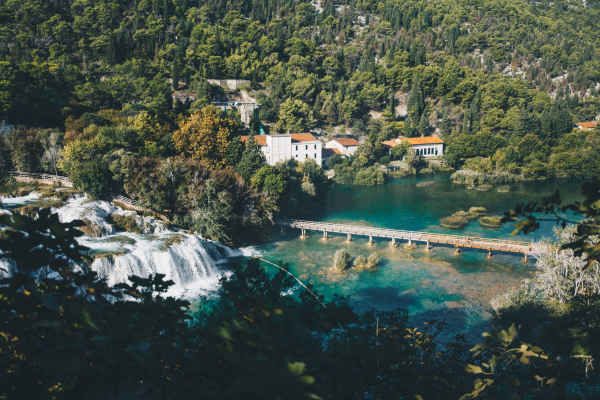
The world is full of intriguing and fascinating natural wonders. Some - like Uluru, Niagara Falls and the Great Barrier Reef are well-trodden by globe trotters. Others, though, have slipped the notice of the global travel community for decades.
This week, we’re dedicating a post to these little-known wonders. We’ve compiled a list of our 8 favourite natural wonders around the world that you’ll find just a little off the beaten track. For a real adventure, check out these gorgeous locations.
Wave Rock in Western Australia
In a country that is known for offering some of the world’s best surfing conditions, it perhaps should come as no surprise that one of its prime natural wonders is named Wave Rock (aptly so!). The windswept, granite inselberg (official name Hyden Rock) is a whopping 2.63 billion years old and towers 15m over the ground. The rock’s curved cliff face, so shaped because of the erosive action of wind and water as well as sedimentary activity over a great many years, resembles an imposing wave that is about to break. And boy, it’s a truly stunning swell!
Plitvice Lakes in Croatia
A national icon, Croatia’s Plitvice Lakes are a must-see for any traveller doing a trip around the area. It truly is an incredibly beautiful place – so much so, that it was granted UNESCO world heritage status in 1979. Surrounded by verdant trees and moss-covered rocks, its otherworldly cascades and 16 turquoise pools are a real treat to the eyes. There are also caves to be explored on a day-long bicycle tour or hike – amateur hikers can get breath-taking views of the waterfalls on the many suspended wooden walkways while more seasoned hikers can opt for the slightly rougher dirt paths.
Caño Cristales River, Colombia
With Colombia already having a reputation for outstanding natural landscapes, it comes as no surprise that it is also the place where you can find a visually striking river featuring (ok – almost) all the colours of a rainbow. The river’s fiery reds, bright yellows and citric green have deservedly earned it the nickname “River of Five Colours”. The river, which is located in Colombia’s National Park of La Macarena, is often called the most beautiful river in the world.
Saturnia Thermal Springs, Tuscany
If you find yourself venturing into beautiful Tuscany and fancy a jacuzzi-like experience worthy of a 5-star hotel, you can’t miss the azure hot springs of Saturnia. The ancient sulphurous springs, who were already well-liked by the Etruscans and later the Romans, feature crystal clear cascades and turquoise limestone pools. Besides offering a mesmerizing view, the natural pools are also a great place to take a dip in, the water being a pleasant 37.5 degrees celsius. And, if against all odds you should be left craving a real hotel-experience after all, Saturnia offers a number of luxurious wellness resorts and spa centres for you to engage your senses in.
Königssee (King’s Lake), Bavaria
Only a truly majestic lake would be deserving of such a grand name – and we’re delighted to share that the King’s Lake does not disappoint, which is why we included it here. One of Bavaria’s most treasured natural attractions, the lake is nestled between the region’s famous steep mountain slopes and dense forests and truly is a sight to behold. The lake’s water is of an emerald green colour, lending the lake additional breathtaking beauty. The lake can be visited by electric boat - the trips usually feature a stop at the Sankt Bartholomä, a picturesque 17th century Roman Catholic pilgrimage church.
Giant’s Causeway, Northern Ireland
A natural reserve located in Northern Ireland, the Giant’s Causeway consists of a rather peculiar grouping of around 40,000 basalt columns resembling increasingly low steps leading into the sea. This slightly unusual landscape of peculiar cobbled shapes has led to its deserved inclusion in UNESCO’s World Heritage Site list. You might hear whispered words spelling out a local legend according to which the cobbled path into the sea was built by – yes – a giant, but for now, we’ll list this one as a natural wonder caused by ancient volcanic activity.
Beehive Stones, Hungary
You could be forgiven if you for a second thought that this beehive rock formation is in Turkey’s UNESCO-listed Cappadocia. However this lunar landscape is neither in Turkey nor on the moon but in (surprise!) Hungary, about 200km northeast of the country’s capital Budapest. Their mysterious appearance is due to their often conical towers dotted with niches or cavities, which were formed by millions of years of erosion, precipitation and wind.
Lauterbrunnen Valley, Switzerland
In the depths of the Swiss Alps, one can find a vast, scenic cleft separating the surrounding limestone precipices, creating a valley 3km deep called the Lauterbrunnen Valley. This picturesque and imposing view is complemented by lush green fields with grazing sheep and - let’s not forget – a staggering total of 72 waterfalls, among which Europe’s highest free-falling waterfall. The Staubbach Falls, Lauterbrunnen’s signature fall, drops down the precipice from an astonishing height of almost 300m, which makes for a mindboggling spectacle.
To explore some of these beautiful destinations yourself, why not create a customised itinerary using our online Adventure Planner!






